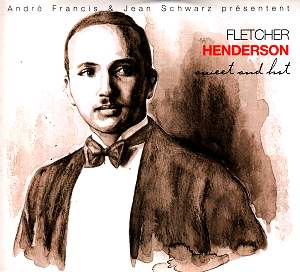CD1
1. Dicty Blues
2. Copenhagen
3. Alabamy Bound
4. Money Blues
5. The Stampede
6. Jackass Blues
7. The Chant
8. The Henderson Stomp
9. Snag It
10. Stockholm Stomp
11. Fidgety Feet
12. St Louis Shuffle
13. Variety Stomp
14. I'm Coming Virginia
15. Whiteman Stomp
16. Goose Pimples
17. Hop Off
18. King Porter Stomp
19. Feeling Good
20. Easy Money
21. Freeze and Melt
22. Blaziní
23. The Wang-Wang Blues
CD2
1. Chinatown, My Chinatown
2. Keep a Song in your Soul
3. Sweet and Hot
4. Sugar Foot Stomp
5. Clarinet Marmalade
6. Hot and Anxious
7. Singiní The Blues
8. New King Porter Stomp
9. Honeysuckle Rose
10. Queer Notions
11 Yeah Man!
12. Hocus Pocus
13. Big John's Special
14 Shanghai Shuffle
15. Wrappiní It Up
16. Rug Cutter's Swing
17. Stealiní Apples
18. Blue Lou
19. Christopher Columbus
20. Jangled Nerves
21. Rhythm of the Tambourine
22. Sing You Sinners
23. There's Rain In My Eyes
24. Moten Stomp (Moten Swing)
Fletcher
Henderson has a lot to answer for. As the
father of big-band orchestration (in cohort
with his chief arranger Don Redman), he introduced
many of the devices subsequently used (and
over-used) by other big bands. He showed how
a large jazz orchestra could be moulded into
an efficient organization and his methods
were widely copied, often slavishly. Many
big bands use similar call-and-response passages
from the reeds and brass, saxophones stating
the melody with interjections from the brass,
and riffs behind solos. Hendersonís arrangements
of numbers like King Porter Stomp and
Big Johnís Special were taken up by Benny
Goodmanís band, assisting Bennyís reputation
as "The King of Swing" and thus
becoming models for subsequent arrangers.
In
fact Fletcher Henderson used these devices
imaginatively, so that a number like Clarinet
Marmalade has lots of different things
going on, with separate elements coming together
to form an intricate whole. Note also such
inventive touches as the asymmetric breaks
in the 1931 version of Sugar Foot Stomp
or Don Redmanís peculiar ending for Copenhagen
which, in Gunther Schullerís words, "leaves
the piece hanging harmonically in mid-air".
As
this double CD shows, Henderson also introduced
or used many musicians who became famous and
influential. At various times his band contained
Louis Armstrong, Cootie Williams, Rex Stewart,
John Kirby, Benny Carter, Henry "Red"
Allen, Tommy Ladnier, Don Redman, Emmett Berry,
Israel Crosby, Buster Bailey, Roy Eldridge,
Chu Berry, Ben Webster, Sid Catlett - and,
of course, Coleman Hawkins, who found his
voice on the tenor sax and influenced generations
of sax players. The Henderson band recorded
Colemanís composition Queer Notions which
was a remarkably prescient anticipation
of future developments in jazz.
This
album illustrates the work of Fletcher Hendersonís
band from 1923 to 1938, although it omits
some important recordings, such as Hot
Mustard, Mandy, Make Up Your Mind, and
Go Ďlong Mule. There are only three of
Louis Armstrongís recordings with the band
(tracks 2-4 of the first CD). Nonetheless,
this selection gives a clear picture of why
Hendersonís band was so influential, and why
his contribution to big-band jazz should never
be underestimated.
Some
years ago, introducing a collection of 64
recordings by Fletcher Henderson, John Hammond
called it "a study in frustration".
He argued that Henderson was frustrated because
his colour deprived him of the success he
deserved Ė a success which was later gained
by the likes of Benny Goodman on the back
of Fletcherís innovations. This double album
is a salutary reminder of Hendersonís pivotal
role in the development of swing and the achievements
of his remarkable bands.
Tony Augarde
